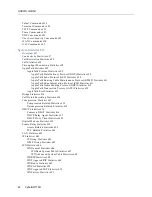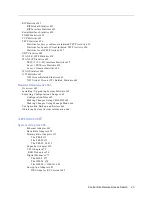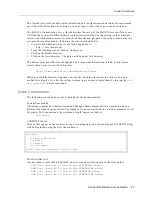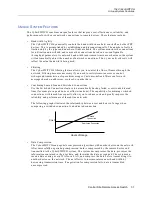
USER’S GUIDE
32 CyberSWITCH
•
Data Encryption
The CyberSWITCH encryption option provides data encryption through the Data Encryption
Standard (DES) algorithm. DES provides data security for transmissions over the WAN
between encryption devices. Options are available for encrypting communications over point-
to-point, frame relay, or Internet-based WANs. For more information, refer to the
Encryption
Overview
and
IP Security
discussions.
To activate the data encryption option on the CyberSWITCH, you will need to properly install
and configure the encryption adapter on the system.
•
Dial Out Capability
The CyberSWITCH system will dial out to remote devices. This feature allows the system to
accept user data received on the Ethernet LAN or ISDN network and initiate a data connection
to the remote device specified in the user data. This allows devices on the local LAN to initiate
connections to networks connected to the system over the switched digital network. The
system monitors the connection for utilization and will remove the connection when it becomes
idle.
•
Digital Modem
The CyberSWITCH’s digital modem capability allows analog modems to be intermixed with
ISDN, as required, to best fit specific networking needs. The digital modem adapter combines
both hardware and software elements to support a number of modems on a single board (from
eight V.34 modems to thirty K56Flex modems, depending upon adapter model). The digital
modem feature conforms to the V.90 standard.
•
Dynamic Management
Manage Mode provides a “real-time” management mechanism that allows many system
parameters to be changed without interrupting the current execution state of the system
software. This feature consists of a series of console commands that enable a user to display
current system parameters, change many parameters dynamically, and write changes to disk
files so that they remain permanent.
•
High Speed Digital Connections
The CyberSWITCH system supports 56Kbps and 64Kbps connections to remote locations.
These dial-up digital connections provide reliable high throughput connections for efficient
data transfer for the same cost as analog connections. If any remote devices connected to the
system support multi-link PPP, up to 32 parallel connections can be made at either 56Kbps or
64Kbps.
•
IP Filters
IP filters allow you to control the transmission of individual IP packets based on the packet
type. You can specify packet type by IP address (source or destination) or by IP protocol (TCP,
UDP, ICMP).
Once you specify a packet type, two forms of IP filtering are available:
•
Forwarding Filters, applied at discrete points of the IP processing path to determine if a
packet continues its normal processing, and a
•
Connection Filter, which determines if an IP packet requiring a WAN connection may con-
tinue.
















































